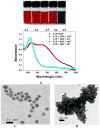Highly sensitive and selective dynamic light-scattering assay for TNT detection using p-ATP attached gold nanoparticle
- PMID: 21077646
- PMCID: PMC3780396
- DOI: 10.1021/am1005139
Highly sensitive and selective dynamic light-scattering assay for TNT detection using p-ATP attached gold nanoparticle
Abstract
TNT is one of the most commonly used nitro aromatic explosives for landmines of military and terrorist activities. As a result, there is an urgent need for rapid and reliable methods for the detection of trace amount of TNT for screenings in airport, analysis of forensic samples, and environmental analysis. Driven by the need to detect trace amounts of TNT from environmental samples, this article demonstrates a label-free, highly selective, and ultrasensitive para-aminothiophenol (p-ATP) modified gold nanoparticle based dynamic light scattering (DLS) probe for TNT recognition in 100 pico molar (pM) level from ethanol:acetonitile mixture solution. Because of the formation of strong π-donor-acceptor interaction between TNT and p-ATP, para-aminothiophenol attached gold nanoparticles undergo aggregation in the presence of TNT, which changes the DLS intensity tremendously. A detailed mechanism for significant DLS intensity change has been discussed. Our experimental results show that TNT can be detected quickly and accurately without any dye tagging in 100 pM level with excellent discrimination against other nitro compounds.
Figures






References
-
- Smith KD, McCord BR, MacCrehan WA, Mount K, Rowe WF. J Forensic Sci. 1999;44:789–794.
-
- Thomas SW, III, Joly GD, Swager TM. Chem Rev. 2007;107:1339–1386. - PubMed
-
- Dillewijn PV, Couselo JL, Corredoira E, Delgado A, Wittich RM, Ballester A, Ramos JL. Environ Sci Technol. 2008;42:7405–7410. - PubMed
-
- Brettell TA, Butler JM, Almirall JR. Anal Chem. 2007;79:4365–4384. - PubMed
Publication types
MeSH terms
Substances
Grants and funding
LinkOut - more resources
Full Text Sources
Other Literature Sources
Research Materials
Miscellaneous

